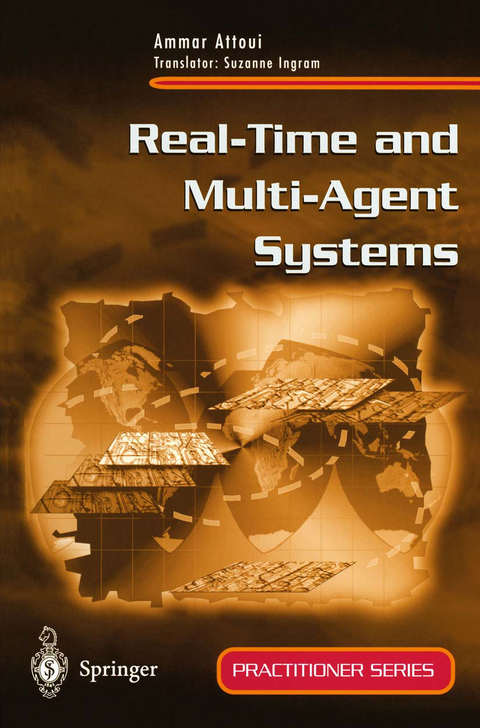
Real-Time and Multi-Agent Systems
Springer London Ltd (Verlag)
978-1-85233-252-5 (ISBN)
1. Problems Encountered with Distributed Systems.- 1.1 Definition of a Distributed Multi-Agent Application.- 1.2 Development of Remote Processing Systems.- 1.3 Architecture of Remote Processing Systems.- 1.4 Distributed Applications.- 1.5 Distributed System Properties.- 1.6 Activity Management in a Distributed Context.- 1.7 Process Synchronization and Resource Management.- 1.8 Validation Protocols for Global Applications.- 1.9 Fault Tolerance, Security and Protection.- 1.10 Conclusion.- 2. Interaction Models.- 2.1 New Generation Distributed Software Architecture.- 2.2 Event-Oriented Concurrent and Distributed Programming.- 2.3 Massively Parallel Processors and Distributed Programming.- 2.4 Basic Principles of Distributed Programming.- 2.5 The Method of Analysis for a Multi-Agent Application.- 2.6 Communication Channels.- 2.7 Elements of a High-Level Distributed Programming Language.- 2.8 Anonymous Communication.- 2.9 Hoare Monitors: High-Level Synchronization and Communication Tools for Parallel Machines with a Global Memory.- 2.10 The Corba Norm.- 2.11 Conclusion.- 3. PVM: Parallel Programming Tools.- 3.1 PVM Presented.- 3.2 PVM Installation.- 3.3 The User Interface or PVM Primitives.- 4. Distributed Programming under Unix.- 4.1 Unix and the Client-Server Model.- 4.2 Unix Tools for Distributed Data-Processing.- 4.3 IP Interfaces.- 4.4 TCP and UDP Data Transmission Protocols.- 4.5 Unix Tools for Distributed Programming.- 4.6 Sockets.- 4.7 Conclusion.- 5. Principles of Real-Time Data-Processing.- 5.1 Structure and Function of an Automated System.- 5.2 Combinatorial Automated Systems.- 5.3 Sequential Automated Systems.- 5.4 The GRAFCET: Synthesis Tool for Industrial Automated Systems.- 5.5 Technological Options for the Implementation of the Command Part.- 5.6 Digital Control Systems for Processes.- 5.7 The Need for an Adapted Specification Methodology.- 5.8 Process Dynamics.- 5.9 Periodic and Aperiodic Tasks.- 5.10 Basic Functions of Real-Time Kernels.- 5.11 Local Industrial Networks.- 5.12 The Development Environment of VxWorks Real-Time Applications.- 5.13 The Environment of a Multi-Agent Real-Time Application.- 5.14 Tools for the Development and Co-verification of Embedded Systems.- 5.15 CORBA Telecommunications.- 6. Prolog III and Real-Time System Engineering.- 6.1 Impact of Formal Specifications on Software Development.- 6.2 Reminder of Discrete Event Systems.- 6.3 Prolog III and the Study of Simple Real-Time Systems.- 6.4 Specification Methodology of Complex MSS Systems.- 6.5 Conclusion.- 6.6 Project 1: Modelling Distributed Systems.- 7. Parallel Image Processing.- 7.1 Presentation.- 7.2 Implementation.- 8. Client-Server Applications under Unix.- 8.1 Presentation.- 8.2 Implementation.- 8.3 Mini Project 1: “An Event Management System”.- 8.4 Mini Project 2: “A VxWorks Version of the Temporal Constraint Manager”.- 8.5 The Sources of the Temporal Constraint Management System.- 9. Control of a Product Processing Chain.- 9.1 Functioning.- 9.2 Analysis and Specification using the SA/RT (SA/SD) Method.- 9.3 Design and Implementation of the Command Part.- 10. Management of Persistent Objects.- 10.1 Presentation.- 10.2 The Object Manager (OM).- Appendix 1: Problems with Hardware-Software Layer Coupling in a Data-Processing System.- A1.1 The Target Machine.- Appendix 2: Basic Principles of Peripheral Handlers.- A2.1 Presentation.- A2.2 General Notes on Programming.- A2.3 Communication between the Kernel and the Handler.- A2.4 Installation Procedure of a New Handler under Unix.- Appendix 3: Process Management.- A3.1 Introduction.-A3.2 Scheduler Implementation Principle.- A3.3 The Scheduler and the Internal Synchronization of Handlers.- Appendix 4: Management of the Central Memory.- A4.1 The Part Supported by Hardware.- A4.2 The Paging Mechanism.- A4.3 The Segmentation Mechanism.- A4.4 Characteristics of Segment Systems.- A4.5 386 Selectors.- A4.6 Segment Descriptors.- A4.7 The Part Supported by the Kernel.- Appendix 5: Introduction to Prolog III.- A5.1 Functioning of a Logic Program.- A5.2 Prolog III.- A5.3 Accepted Expressions.- A5.4 Conclusion.- Bibligraphy.
| Erscheint lt. Verlag | 22.9.2000 |
|---|---|
| Reihe/Serie | Practitioner Series |
| Übersetzer | S. Ingram |
| Zusatzinfo | 282 Illustrations, black and white; XX, 461 p. 282 illus. |
| Verlagsort | England |
| Sprache | englisch |
| Maße | 155 x 235 mm |
| Themenwelt | Mathematik / Informatik ► Informatik ► Betriebssysteme / Server |
| Mathematik / Informatik ► Informatik ► Netzwerke | |
| Mathematik / Informatik ► Informatik ► Theorie / Studium | |
| Schlagworte | Concurrent Systems • Manufacturing Systems • Processor architecture • Real-Time Systems |
| ISBN-10 | 1-85233-252-2 / 1852332522 |
| ISBN-13 | 978-1-85233-252-5 / 9781852332525 |
| Zustand | Neuware |
| Haben Sie eine Frage zum Produkt? |
aus dem Bereich


